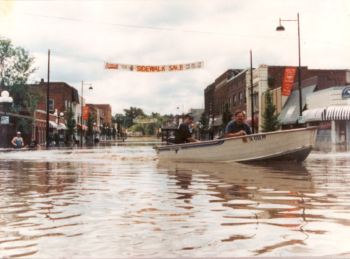
By Michael Swanger
I remember … the pace in which my family filled sandbags to try to save my grandma’s house on the Des Moines side of Historic Valley Junction … the sound of an Iowa National Guardsman using a bullhorn to warn us to evacuate as the levee of the nearby Raccoon River was about to break … the sight of flood water rolling across the dead end street and lapping up against the tires of the pickup truck in which I made my escape … the surreal sensation of surveying the damage the next day from a small boat slowly motoring down the middle of the street … the lukewarm temperature of the chest-high, muddy, river water in which I waded to reach grandma’s front door … and the heartbreaking realization while trudging through waist-deep water in her living room that grandma would lose her possessions and possibly her home.

A boat motors along Fifth Street in Valley Junction during the Great Flood of 1993.
A quarter-century later, my memories of the Great Flood of 1993 have not receded. I doubt they will in my lifetime. Nor will they for Iowans who experienced it, especially those who survived it or lent a helping hand.
The Great Mississippi and Missouri Rivers Flood of 1993 devastated nine Midwestern states and several cities along those two mighty rivers and their tributaries from May to October, leaving behind $15 billion in damages. It was the worst such U.S. disaster since the Great Mississippi Flood of 1927.
Heavy snowfall during the 1992-1993 winter, combined with unprecedented amounts of rain in the spring and summer, below average temperatures, high soil moisture and reservoir levels, as well as recurring thunderstorms in the same areas were among the contributing factors that led to the Great Flood of 1993. As much as 48 inches of rainfall was measured between April 1 and Aug. 1 in portions of east-central Iowa. By June 1, the soil was so saturated that rainfall ran into streams and rivers. Through the middle of August, Iowa experienced 12 consecutive weeks of above-average rainfall, which resulted in extensive flooding in all 99 counties.
My wife and I, who were dating at the time, spent the July 4th weekend at a blues festival in Davenport where we saw flooding from the Mississippi River. It was a devastating sight. Little did we know it would foreshadow the tragic events to follow one week later in our hometown of West Des Moines, where the homes of our relatives, friends and neighbors would be ravaged by flood waters.
Severe thunderstorms dumped seven to eight inches of rain across the state on July 8. The next day, Hilton Coliseum in Ames was deluged with 14 feet of water while residents in Des Moines and Valley Junction rallied to sandbag and brace for the worst.
Sunday, July 10, was a sunny day. Then the levee broke in two places and the Iowa National Guard shut down parts of Des Moines and Valley Junction that night, forcing the evacuation of 5,000 people.
At about 3 a.m. on July 11, conditions worsened in the Des Moines metro when officials at Des Moines Water Works were forced to turn off the pumps as the neighboring Raccoon River flooded and submerged the water treatment plant. Nearly 225,000 people would go without running water from July 11 to July 22. Those who experienced the 19 agonizing days without drinking water remember the water distribution sites and the joy of being able to bathe and flush toilets when running water was restored on July 22, even though we couldn’t drink it for another week.
For most, routine life resumed with the return of drinking water. For those whose homes were severely flooded, but salvageable, the arduous work to clean up the muddy mess and rebuild began.
For some, like grandma, life was never the same. She didn’t fully recover from the effects of the flood and died two years later. Others were unable to rebuild and their homes were razed.
The worst of times, however, brought out the best in people. Grandma lived with us for a while as our family, friends and volunteers rebuilt her house so she could reclaim it before she died. Those memories I cherish the most 25 years later.
TO READ MORE FASCINATING STORIES ABOUT IOWA HISTORY, subscribe to Iowa History Journal. You can also purchase back issues at the store.
